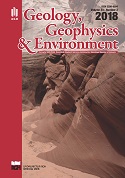Application of radial electrical resistivity profile array for mapping deep vertical fractures in a proposed engineering construction site within the University of Ibadan Campus, Southwestern Nigeria
DOI:
https://doi.org/10.7494/geol.2018.44.3.329Keywords:
radial profile array, vertical fracture, narrow azimuth survey, proposed construction siteAbstract
In this study we demonstrate the efficacy of radial electrical resistivity profile array in delineating deep narrow linear fracture that could constitute weakness in the subsurface, thus hindering foundation material in providing necessary support to proposed engineering construction, in the southeastern part of the University of Ibadan Campus, southwestern Nigeria, where nearby buildings show stress induced failure traceable to defect in foundation upon which the buildings were founded. Six electrical resistivity profile arrays were occupied at 0°/180°, 307210°, 607240°, 907270, 1207300° and 1507330° orientations to complete a clockwise 360° sweep at 30° interval. The radial profile array enabled subsurface features to be intersected at relatively high angle, thus making measurement of linear features of limited lateral extent feasible irrespective of their orientations. Low resistivity distribution which decreases in value with depth (300-8 Om) characterizes the northern part of the study area while relatively higher value that increases with depth (420-4150 Om) dominates the south. The occurrence of a narrow strip of low resistivity zone (8-170 Om) at 20 m, which gains prominence with depth, dividing relatively resistive zone in the southern part of the study area indicate the presence of a deep vertical fracture whose detection is essential to guide further foundation geotechnical studies as well as aid the design of appropriate foundation that would support the proposed engineering structure.Downloads
References
Banerjee B. & Pal B.A., 1986. A simple method for determination of depth of investigation characteristics in resistivity prospecting. Exploration Geophysics, 17, 93-95.
Briggs I.C., 1974. Machine contouring using minimum curvature. Geophysics, 39,39-48.
Dahlin T. & Zhou B., 2004. A numerical comparison of 2D resistivity imaging with 10 electrode arrays. Geophysical Prospecting, 52, 5, 379-398.
Elueze A.A.& Okunlola O.A., 2003. Petrochemical and Petrogenetic Characteristics of Metasedimentary Rocks of Lokoja-Jakura Schist Belt, Central Nigeria. Journal of Mining and Geology, 39, 1, 21-27.
Evjen H.M., 1938. Depth factor and resolving power of electrical measurements. Geophysics, 3, 78-85.
Hennig T., Weller A. & Moller M., 2008. Object orientated focussing of geoelectrical multielectrode measurements. Journal of Applied Geophysics, 65, 2, 57-64.
Inman J.R., Ryu J. & Ward S.H., 1973. Resistivity inversion. Geophysics, 38, 6, 1088-1108.
Loke M.H., 1999. A practical guide to 2D and 3D surveys. Electrical imaging surveys for environmental and engineering studies. Geotomo software, Malaysia, 8-10, [on-line:] http://www.heritagegeophysics.com/images/ lokenote.pdf [access: 24.03.2018].
Loke M.H., 2000. Topographic modelling in resistivity imaging inversion. [in:] Extended Abstracts Book, EAGE 62nd Conference and Technical Exhibition: Glasgow, Scotland, 29 May - 2 June 2000, European Association of Geoscientists & Engineers, D-2.
Loke M.H., Chambers J.E., Rucker D.F., Kuras O. & Wilkinson P.B., 2013. Recent developments in the direct-current geoelectrical imaging method. Journal of Applied Geophysics, 95, 135-156.
Pazdirek O. & Blaha V., 1996. Examples of resistivity imaging using ME-100 resistivity field acquisition system. [in:] Extended Abstracts Book 58th EAGE Conference and Technical Exhibition, Amsterdam, The Netherlands, 3-7 June 1996, European Association of Geosciencists & Engineers. DOI: 10.3997/2214-4609.201408817.
Ronning J.S., Dalsegg E., Elvebakk H. & Storro G., 2003. Characterization of fracture zones in bedrock using 2D resistivity. [in:] 9th European Meeting of Environmental and Engineering Geophysics, August 31 - September 4, Prague, Czech Republic, Czech Association of the Applied Geophysicists, Czech Republic, P-005. DOI: 10.3997/2214-4609.201414578.
Roy A. & Apparao A., 1971. Depth of investigation in direct current methods. Geophysics, 36, 943-959.
Sasaki Y., 1989. Two-dimensional joint inversion of magnetotelluric and dipole-dipole resistivity data. Geophysics, 54, 254-262.
Seaton W.J. & Burbey T.J., 2002. Evaluation of two-dimensional resistivity methods in a fractured crystalline-rock terrain. Journal of Applied Geophysics, 51, 21-41.
Stummer P., Maurer H. & Green A.G., 2004. Experimental design: electrical resistivity data sets that provide optimum subsurface information. Geophysics, 69, 1, 120-139.
White R.M.S., Collins S. & Loke M.H., 2003. Resistivity and IP arrays, optimised for data collection and inversion. Exploration Geophysics, 34, 229-232.
Downloads
Published
Issue
Section
License
Authors have full copyright and property rights to their work. Their copyrights to store the work, duplicate it in printing (as well as in the form of a digital CD recording), to make it available in the digital form, on the Internet and putting into circulation multiplied copies of the work worldwide are unlimited.
The content of the journal is freely available according to the Creative Commons License Attribution 4.0 International (CC BY 4.0)










